From the Trenches
Jetting Across the British Isles
By JASON URBANUS
Thursday, October 10, 2019
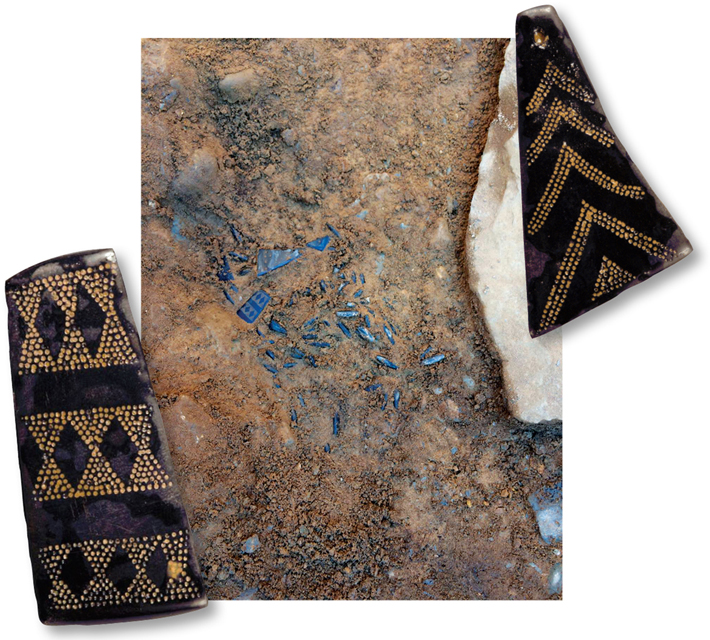 Queen Victoria is known for wearing only black clothing during a mourning period for her beloved Albert that endured for no less than 40 years. She even went so far as to favor black jewelry made from jet, a gemstone that is composed of fossilized wood from a type of Jurassic-period British coniferous tree. But the queen was not the first Briton to wear jet jewelry. Archaeologists recently unearthed a jet necklace dating to sometime between 2200 and 1900 B.C. in a tomb under an earthen mound near the village of Kirk Michael on the Isle of Man.
Queen Victoria is known for wearing only black clothing during a mourning period for her beloved Albert that endured for no less than 40 years. She even went so far as to favor black jewelry made from jet, a gemstone that is composed of fossilized wood from a type of Jurassic-period British coniferous tree. But the queen was not the first Briton to wear jet jewelry. Archaeologists recently unearthed a jet necklace dating to sometime between 2200 and 1900 B.C. in a tomb under an earthen mound near the village of Kirk Michael on the Isle of Man.
The crescent-shaped necklace consists of 122 decorated beads between 0.4 and 2 inches long. These jet gemstones came from Yorkshire, in northern England, suggesting that communities on the Isle of Man were connected to far-flung trade and exchange networks 4,000 years ago. “Whether or not the person who wore the beads lived on the Isle of Man for their whole life, left and returned, or was born elsewhere,” says project codirector and Newcastle University archaeologist Chris Fowler, “the beads can be taken as an indication that this was a person of some importance because of the rarity of the material and its exotic nature.”
Rise of the Greek Crane
By JASON URBANUS
Thursday, October 10, 2019
 Ancient Greece is renowned for its extraordinary stone temples. Structures such as the Parthenon were only made possible by the invention of the crane, which is considered to be one the Greeks’ greatest technological innovations. The device allowed heavy blocks to be lifted and set into place using relatively few men. “Lifting methods previously employed by the Greeks, as well as by other ancient cultures, required large ramps and scaffolds of earth or mudbrick,” says University of Notre Dame architectural historian Alessandro Pierattini. “Building and dismantling such massive earthworks required a large workforce.”
Ancient Greece is renowned for its extraordinary stone temples. Structures such as the Parthenon were only made possible by the invention of the crane, which is considered to be one the Greeks’ greatest technological innovations. The device allowed heavy blocks to be lifted and set into place using relatively few men. “Lifting methods previously employed by the Greeks, as well as by other ancient cultures, required large ramps and scaffolds of earth or mudbrick,” says University of Notre Dame architectural historian Alessandro Pierattini. “Building and dismantling such massive earthworks required a large workforce.”
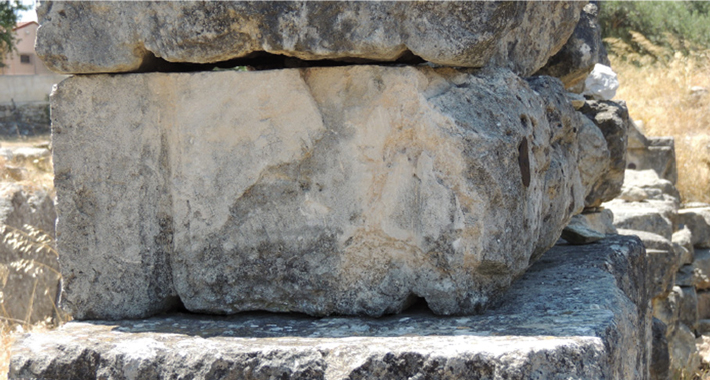 It has long been thought that the crane was developed toward the end of the sixth century B.C. However, Pierattini suggests that the Greeks experimented with crane technology at least a century earlier. By reexamining ashlar blocks from the Temples of Apollo at Corinth and Poseidon at Isthmia—the oldest-known Greek temples built from stone—he determined that grooves cut into the bottom and sides of these blocks were used to secure ropes attached to a primitive lifting device. Levers could also be inserted into the blocks, which weighed as much as 850 pounds, helping to maneuver them into their final position.
It has long been thought that the crane was developed toward the end of the sixth century B.C. However, Pierattini suggests that the Greeks experimented with crane technology at least a century earlier. By reexamining ashlar blocks from the Temples of Apollo at Corinth and Poseidon at Isthmia—the oldest-known Greek temples built from stone—he determined that grooves cut into the bottom and sides of these blocks were used to secure ropes attached to a primitive lifting device. Levers could also be inserted into the blocks, which weighed as much as 850 pounds, helping to maneuver them into their final position.
Æthelburga's Local Church
By JASON URBANUS
Thursday, October 10, 2019
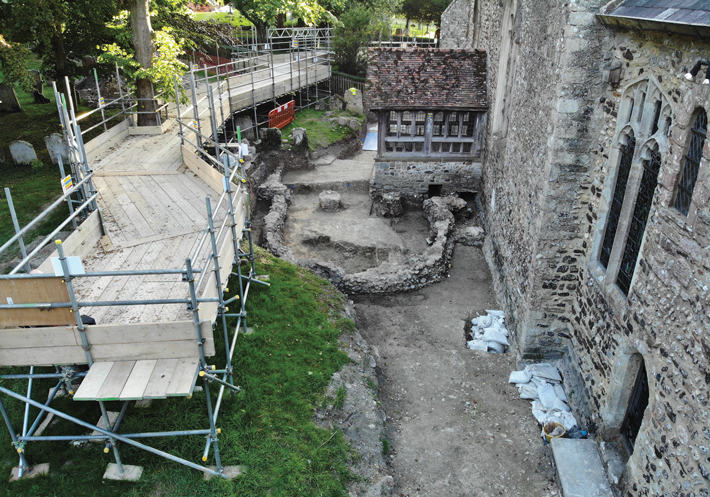 Excavations near an eleventh-century church in Lyminge, Kent, have exposed the foundations of an ancient predecessor. The Anglo-Saxon building dates to the mid-seventh century, just a few decades after Christianity, which had largely disappeared from Britain following the departure of the Romans in the early fifth century, was reintroduced by St. Augustine of Canterbury. One of the oldest stone churches in England, the seventh-century building was partially unearthed and then reburied in the nineteenth century, but a new project led by Gabor Thomas of the University of Reading is reinvestigating and documenting the site using modern archaeological methods. “Only a handful of stone churches dating from the earliest phase of English Christianity survive to the present day,” says Thomas. “Very few opportunities have arisen to explore these sites archaeologically.”
Excavations near an eleventh-century church in Lyminge, Kent, have exposed the foundations of an ancient predecessor. The Anglo-Saxon building dates to the mid-seventh century, just a few decades after Christianity, which had largely disappeared from Britain following the departure of the Romans in the early fifth century, was reintroduced by St. Augustine of Canterbury. One of the oldest stone churches in England, the seventh-century building was partially unearthed and then reburied in the nineteenth century, but a new project led by Gabor Thomas of the University of Reading is reinvestigating and documenting the site using modern archaeological methods. “Only a handful of stone churches dating from the earliest phase of English Christianity survive to the present day,” says Thomas. “Very few opportunities have arisen to explore these sites archaeologically.”
The church is thought to have been foundedby Æthelburga, princess of Kent and queen of Northumbria, whose empty tomb may have been identified in a small annex attached to the building’s exterior. Additional work nearby has uncovered traces of the monastic community that developed around the church.
Down by the River
By DANIEL WEISS
Thursday, October 10, 2019
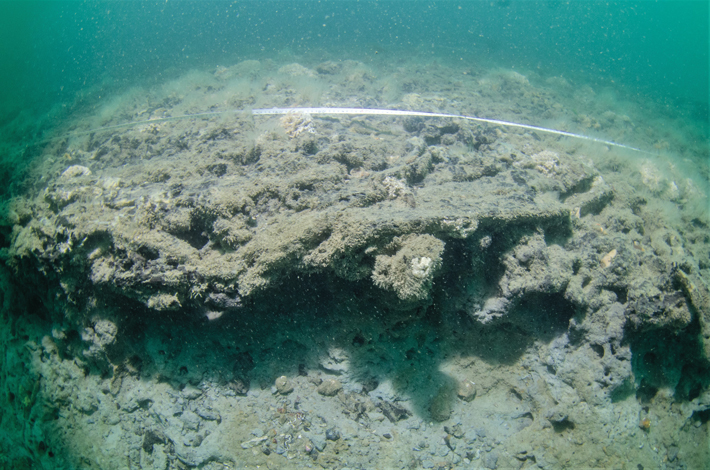 An 8,000-year-old wooden platform has been discovered on the seabed off the Isle of Wight. The platform, which has been excavated by researchers from the Maritime Archaeology Trust (MAT) and taken to a laboratory for study, lay under more than 30 feet of water. At the time it was built, however, sea levels were much lower, and the area was heavily wooded and abutted a waterway. The newly identified structure, which measures about seven feet by three feet and may have originally been substantially larger, consists of layers of split wood resting on a perpendicular log foundation. It was identified by divers after it eroded out of the seabed. Building the platform would have required woodworking skills that were not thought to have been developed in this region until several thousand years later. “This is the most cohesive, most intact Mesolithic structure to have been excavated in the United Kingdom,” says Garry Momber, MAT’s director. The platform was situated near a boatbuilding site, where the wood scraps used to construct it would have been found.
An 8,000-year-old wooden platform has been discovered on the seabed off the Isle of Wight. The platform, which has been excavated by researchers from the Maritime Archaeology Trust (MAT) and taken to a laboratory for study, lay under more than 30 feet of water. At the time it was built, however, sea levels were much lower, and the area was heavily wooded and abutted a waterway. The newly identified structure, which measures about seven feet by three feet and may have originally been substantially larger, consists of layers of split wood resting on a perpendicular log foundation. It was identified by divers after it eroded out of the seabed. Building the platform would have required woodworking skills that were not thought to have been developed in this region until several thousand years later. “This is the most cohesive, most intact Mesolithic structure to have been excavated in the United Kingdom,” says Garry Momber, MAT’s director. The platform was situated near a boatbuilding site, where the wood scraps used to construct it would have been found.
Egypt's Temple Town
By BENJAMIN LEONARD
Thursday, October 10, 2019
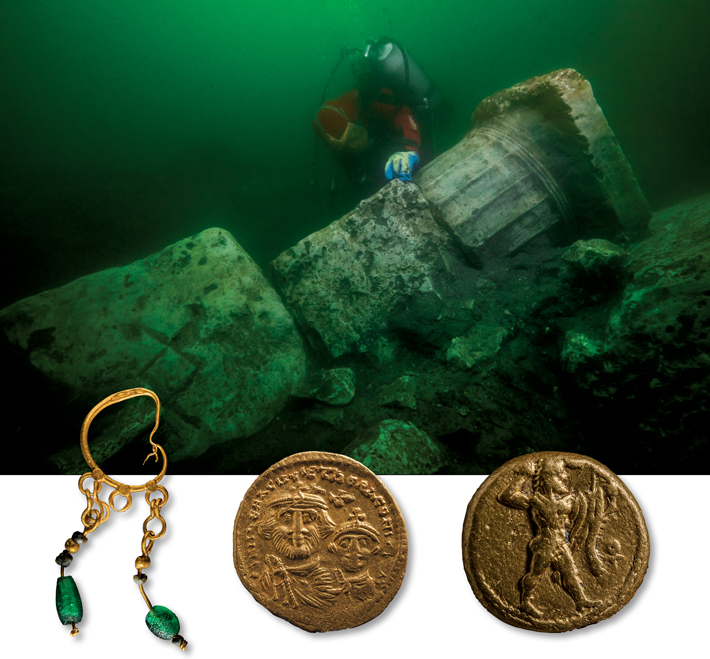 Before the rise of Alexandria in the fourth century B.C., the ancient port city of Thonis-Heracleion at the mouth of the Nile was the gateway to Egypt for foreign traders. The city and a suburb, Canopus, also served as a center of Egyptian religious life before a series of natural disasters submerged them by the eighth century A.D.
Before the rise of Alexandria in the fourth century B.C., the ancient port city of Thonis-Heracleion at the mouth of the Nile was the gateway to Egypt for foreign traders. The city and a suburb, Canopus, also served as a center of Egyptian religious life before a series of natural disasters submerged them by the eighth century A.D.
Recent excavations in a channel south of Thonis-Heracleion’s main temple to the god Amun-Gereb have uncovered debris from its destruction around 140 B.C. Wedged among the building’s blocks and columns were hundreds of mostly intact ritual artifacts, ceramics, and bronze coins from the reign of Ptolemy II (r. 285–246 B.C.). Across from the temple’s entrance, archaeologists discovered Doric columns belonging to a circular Greek temple. Thonis-Heracleion’s surfeit of sanctuaries, including temples dedicated to Hercules and Osiris, was a result of official favor bestowed on it for its economic significance. “The city was of prime importance to the pharaonic dynasties, which relied on it for taxes and customs duties,” says Franck Goddio of the European Institute for Underwater Archaeology.
Advertisement
Advertisement
IN THIS ISSUE
From the Trenches
Proof Positive
Off the Grid
The Wrath of the Hittites
Melting Season
Provincial Pen Pal
Megalithic Mystery
Worlds Apart
The Lead Standard
Egypt's Temple Town
Æthelburga's Local Church
Down by the River
Rise of the Greek Crane
Jetting Across the British Isles
World Roundup
Island hopping to Australia, Dead Sea Scroll survival, Roman social security, and the village Canada forgot
Artifact
Another face in the crowd
Advertisement

Recent Issues
-
 May/June 2024
May/June 2024
-
 March/April 2024
March/April 2024
-
 January/February 2024
January/February 2024
-
 November/December 2023
November/December 2023
-
 September/October 2023
September/October 2023
-
 July/August 2023
July/August 2023
-
 May/June 2023
May/June 2023
-
 March/April 2023
March/April 2023
-
 January/February 2023
January/February 2023
-
 November/December 2022
November/December 2022
-
 September/October 2022
September/October 2022
-
 July/August 2022
July/August 2022
-
 May/June 2022
May/June 2022
-
 March/April 2022
March/April 2022
-
 January/February 2022
January/February 2022
-
 November/December 2021
November/December 2021
-
 September/October 2021
September/October 2021
-
 July/August 2021
July/August 2021
-
 May/June 2021
May/June 2021
-
 March/April 2021
March/April 2021
-
 January/February 2021
January/February 2021
-
 November/December 2020
November/December 2020
-
 September/October 2020
September/October 2020
-
 July/August 2020
July/August 2020
-
 May/June 2020
May/June 2020
-
 March/April 2020
March/April 2020
-
 January/February 2020
January/February 2020
-
 November/December 2019
November/December 2019
-
 September/October 2019
September/October 2019
-
 July/August 2019
July/August 2019
-
 May/June 2019
May/June 2019
-
 March/April 2019
March/April 2019
-
 January/February 2019
January/February 2019
-
 November/December 2018
November/December 2018
-
 September/October 2018
September/October 2018
-
 July/August 2018
July/August 2018
-
 May/June 2018
May/June 2018
-
 March/April 2018
March/April 2018
-
 January/February 2018
January/February 2018
-
 November/December 2017
November/December 2017
-
 September/October 2017
September/October 2017
-
 July/August 2017
July/August 2017
-
 May/June 2017
May/June 2017
-
 March/April 2017
March/April 2017
-
 January/February 2017
January/February 2017
-
 November/December 2016
November/December 2016
-
 September/October 2016
September/October 2016
-
 July/August 2016
July/August 2016
-
 May/June 2016
May/June 2016
-
 March/April 2016
March/April 2016
-
 January/February 2016
January/February 2016
-
 November/December 2015
November/December 2015
-
 September/October 2015
September/October 2015
-
 July/August 2015
July/August 2015
-
 May/June 2015
May/June 2015
-
 March/April 2015
March/April 2015
-
 January/February 2015
January/February 2015
-
 November/December 2014
November/December 2014
-
 September/October 2014
September/October 2014
-
 July/August 2014
July/August 2014
-
 May/June 2014
May/June 2014
-
 March/April 2014
March/April 2014
-
 January/February 2014
January/February 2014
-
 November/December 2013
November/December 2013
-
 September/October 2013
September/October 2013
-
 July/August 2013
July/August 2013
-
 May/June 2013
May/June 2013
-
 March/April 2013
March/April 2013
-
 January/February 2013
January/February 2013
-
 November/December 2012
November/December 2012
-
 September/October 2012
September/October 2012
-
 July/August 2012
July/August 2012
-
 May/June 2012
May/June 2012
-
 March/April 2012
March/April 2012
-
 January/February 2012
January/February 2012
-
 November/December 2011
November/December 2011
-
 September/October 2011
September/October 2011
-
 July/August 2011
July/August 2011
-
 May/June 2011
May/June 2011
-
 March/April 2011
March/April 2011
-
 January/February 2011
January/February 2011
Advertisement






